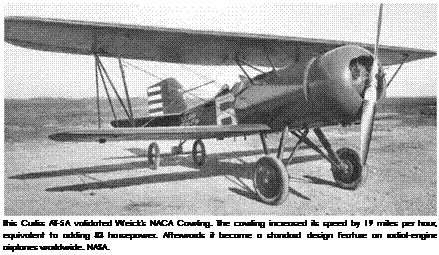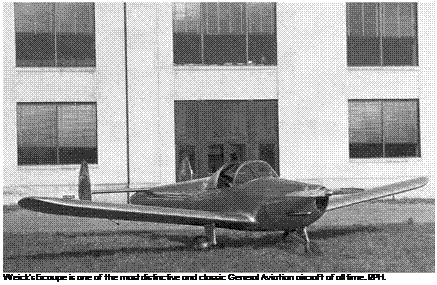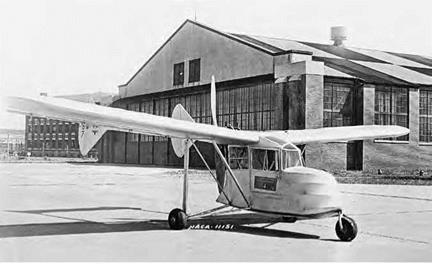The Early Evolution of General Aviation
The National Advisory Committee for Aeronautics (NACA) was formed on March 3, 1915, to provide advice and carry out much of cutting-edge research in aeronautics in the United States. This organization was modeled on the British Advisory Committee for Aeronautics. President Woodrow Wilson created the advisory committee in an effort to organize American aeronautical research and raise it to the level of European aviation. Its charter and $5,000 initial appropriation (low even in 1915) were appended to a naval appropriations bill and passed with little fanfare. The committee’s mission was "to supervise and direct the scientific study of the problems of flight, with a view to their practical solution,” and to "direct and conduct research and experiment in aeronautics.”[775] Thus, from its outset, it was far more than simply a bureaucratic panel distanced from design-shop, laboratory, and flight line.
The NACA soon involved itself across the field of American aeronautics, advising the Government and industry on a wide range of issues including establishing the national air mail service, along with its night mail operations, and brokering a solution—the crosslicensing of aeronautics patents—to the enervating Wright-Curtiss patent feud that had hampered American aviation development in the pre-World War I era and that continued to do so even as American forces were fighting overseas. The NACA proposed establishing a Bureau of Aeronautics in the Commerce Department, granting funds to the Weather Bureau to promote safety in aerial navigation, licensing of pilots, aircraft inspections, and expanding airmail. It also made recommendations in 1925 to President Calvin Coolidge’s Morrow Board that led to passage of the Air Commerce Act of 1926, the first Federal legislation regulating civil aeronautics. It continued to provide policy recommendations on the Nation’s aviation until its incorporation in the National Aeronautics and Space Administration (NASA) in 1958.[776]
The NACA started working in the field of GA almost as soon as it was established. Its first research airplane programs, undertaken primarily by F. H. Norton, involved studying the flight performance, stability and control, and handling qualities of Curtiss JN-4H, America’s iconic "Jenny” of the "Great War” time period, and one that became first great American GA airplane as well.[777] The initial aerodynamic and performance studies of Dr. Max M. Munk, a towering figure in the history of fluid mechanics, profoundly influenced the Agency’s subsequent approach to aerodynamic research. Munk, the inventor of the variable – density wind tunnel (which put NACA aerodynamics research at the forefront of the world standard) and architect of American aerodynamic research methodology, dramatically transformed the Agency’s approach to airfoil design by introducing the methods of the "Prandtl school” at Gottingen and by designing and supervising the construction of a radical new form of wind tunnel, the so-called "variable density tunnel.” His GA influence began with a detailed study of the airflow around and through a biplane wing cellule (the upper and lower wings, connected with struts and wires, considered as a single design element). He produced a report in which the variation of the section, chord, gap, stagger, and decalage (the angle of incidence of the respective chords of the upper and lower wings) and their influence upon the available wing cell space for engines, cockpits, passenger, and luggage, were investigated with a great number of calculated examples in which all of the numerical results were given in tables. Munk’s report was in some respects a prototypical example of subsequent NACA-NASA research reports that, over the years, would prove beneficial to the development of GA by investigating a number of areas of particular concern, such as aircraft aerodynamic design, flight safety, spin prevention and recoveries, and handling qualities.[778] Arguably these reports that conveyed Agency research results to a public audience were the most influential product of NACA-NASA research. They influenced not only the practice of engineering within the various aircraft manufacturers, but provided the latest information incorporated in many aeronautical engineering textbooks used in engineering schools.
Though light aircraft are often seen as the by-product of the air transport revolution, in fact, they led, not followed, the expansion of commercial aviation, particularly in the United States. The interwar years saw an explosive growth in American aeronautics, particularly private flying and GA. It is fair to state that the roots of the American air transport revolution were nurtured by individual entrepreneurs manufacturing light aircraft and beginning air mail and air transport services, rather than (as in Europe) largely by "top-down” government direction. As early as 1923, American fixed-base operators "carried 80,888 passengers and 208,302 pounds of freight.”[779] In 1926, there were a total of 41 private airplanes registered with the Federal Government. Just three years later, there were 1,454. The Depression severely curtailed private ownership, but although the number of private airplanes plummeted to 241 in 1932, it rose steadily thereafter to 1,473 in 1938, with Wichita, KS, emerging as the Nation’s center of GA production, a distinction it still holds.[780]
Two of the many notable NACA-NASA engineers who were influenced by their exposure to Max Munk and had a special interest in GA, and who in turn greatly influenced subsequent aircraft design, were Fred E. Weick and Robert T. Jones. Weick arrived at NACA Langley Field, VA, in the 1920s after first working for the U. S. Navy’s Bureau of Aeronautics.[781] Weick subsequently conceived the NACA cowling that became a feature of radial-piston-engine civil and military aircraft design. The cowling both improved the cooling of such engines and streamlined the engine installation, reducing drag and enabling aircraft to fly higher and faster.
 |
|
In late fall of 1934, Robert T. Jones, then 23 years old, started a temporary, 9-month job at Langley as a scientific aide. He would remain with the Agency and NASA afterwards for the next half-century, being particularly known for having independently discovered the benefits of wing sweep for transonic and supersonic flight. Despite his youth, Jones already had greater mathematical ability than any other of his coworkers, who soon sought his expertise for various theoretical analyses. Jones was a former Capitol Hill elevator operator and had previously been a designer for the Nicholas Beazley Company in Marshall, MO. The Great Depression collapsed the company and forced him to seek other employment. His work as an elevator operator allowed him to hone his mathematical abilities gaining him the patronage of senior officials who arranged for his employment by the NACA.[782]
Jones and Weick formed a fruitful collaboration, exemplified by a joint report they prepared on the status of NACA lateral control research. Two things were considered of primary importance in judging the effectiveness of different control devices: the calculated banking and yawing motion of a typical small airplane caused by control deflection, and the stick force required to produce this control deflection. The report included a table in which a number of different lateral control devices
were compared.[783] Unlike Jones, Weick eventually left the NACA to continue his work in the GA field, producing a succession of designs emphasizing inherent stability and stall resistance. His research mirrored Federal interest in developing cheap, yet safe, GA aircraft, an effort that resulted in a well-publicized design competition by the Department of Commerce that was won by the innovative Stearman-Hammond Model Y of 1936. Weick had designed a contender himself, the W-1, and though he did not win, his continued research led him to soon develop one of the most distinctive and iconic "safe” aircraft of all time, his twin-fin and single-engine Ercoupe. It is perhaps a telling comment that Jones, one of aeronautics’ most profound scientists, himself maintained and flew an Ercoupe into the 1980s.[784]
|
The Weick W-1 was an early example of attempting to build a cheap yet safe General Aviation airplane. NASA. |
The NACA-NASA contributions to GA have come from research, development, test, and evaluation within the classic disciplines of aerodynamics, structures, propulsion, and controls but have also involved functional areas such as aircraft handling qualities and aircrew
 |
|
performance, aviation safety, aviation meteorology, air traffic control, and education and training. The following are selected examples of such work, and how it has influenced and been adapted, applied, and exploited by the GA community.











